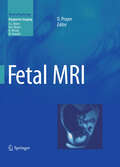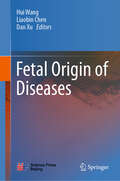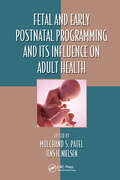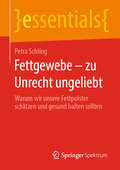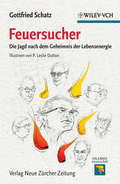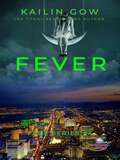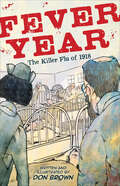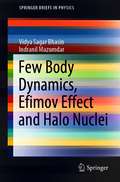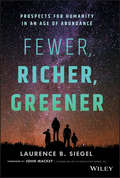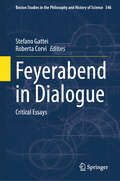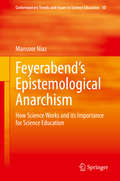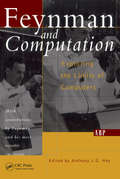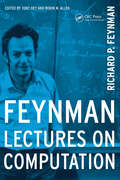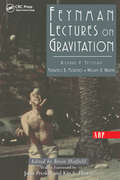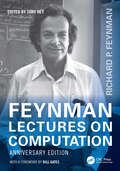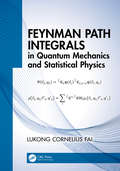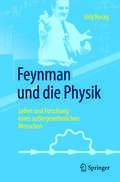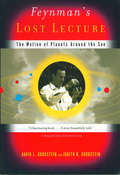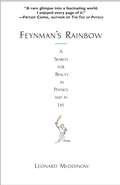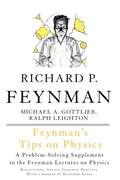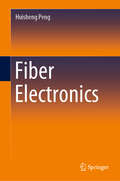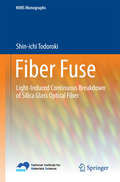- Table View
- List View
Fetal MRI
by Daniela Prayer Albert L. BaertThis is the most comprehensive book written on the subject of fetal MRI. It provides a practical hands-on approach to the use of state-of-the-art MRI techniques and the optimization of sequences. The book also contains numerous high-quality illustrations.
Fetal Medicine for the MRCOG and Beyond
by Alan Cameron Janet Brennand Lena Crichton Janice GibsonA solid understanding of fetal medicine is essential for the practice of obstetrics and gynaecology. This comprehensive book, which has been extensively updated to reflect current clinical practice and developments in the field since publication of the original edition, provides a thorough overview of fetal medicine, covering: screening for chromosomal abnormalities; prenatal diagnostic techniques; the routine anomaly scan; fetal structural abnormalities; fetal therapy; prenatal diagnosis and management of non-immune hydrops fetalis; termination of pregnancy for fetal abnormality; fetal growth restriction; twin pregnancy; and fetal infection. The book is primarily designed to provide a comprehensive summary for candidates preparing for the Part 2 MRCOG examination, and as such covers the RCOG curriculum for fetal medicine. It is also a valuable guide for all healthcare professionals working in the field, including trainees, consultants and midwives.
Fetal Origin of Diseases
by Dan Xu Hui Wang Liaobin ChenThis book covers two decades of the author’s studies about fetal-originated diseases. It contains researches from the aspects of multiple inducing factors of fetal-originated diseases, including prenatal xenobiotic exposure, nutritional deficiency and other adverse environment during pregnancy. The authors introduce a series of animal models for studying the fetal origin of a variety of metabolic and neuropsychiatric diseases, and propose the mechanisms of developmental toxicity and susceptibility to multiple diseases, such as glucocorticoid programming. Moreover, the extended knowledge are also clearly addressed, like identification of biomarkers of developmental toxicity, and the strategies for early warning, prevention and treatment of fetal-originated diseases. Thus, the book is a systematic and complete reference for the researchers of related areas.
Fetal and Early Postnatal Programming and its Influence on Adult Health (Oxidative Stress and Disease)
by Mulchand S. Patel Jens H. NielsenThere is a documented link between fetal nutrition and the development of disease risk in adult life. Including the early postnatal period, during which a newborn continues to grow rapidly influenced by environmental factors, suggests that individuals are subject to risks for more than just the fetal period. Fetal and Early Postnatal Programming and its Influence on Adult Health focuses on interrelated aspects of cellular programming related to early nutrition and this potential global health problem.
Fetal and Neonatal Lung Development: Clinical Correlates and Technologies for the Future
by Alan H. Jobe Jeffrey A. Whitsett Steven H. AbmanLung disease affects more than 600 million people worldwide. While some of these lung diseases have an obvious developmental component, there is growing appreciation that processes and pathways critical for normal lung development are also important for postnatal tissue homeostasis and are dysregulated in lung disease. This book provides an authoritative review of fetal and neonatal lung development and is designed to provide a diverse group of scientists, spanning the basic to clinical research spectrum, with the latest developments on the cellular and molecular mechanisms of normal lung development and injury-repair processes, and how they are dysregulated in disease. The book covers genetics, omics, and systems biology as well as new imaging techniques that are transforming studies of lung development. The reader will learn where the field of lung development has been, where it is presently, and where it is going in order to improve outcomes for patients with common and rare lung diseases. Provides an authoritative review of fetal and neonatal lung development. Designed to provide a diverse group of scientists with the latest developments on the cellular and molecular mechanisms of normal lung development and injury-repair processes. Covers genetics, omics, and systems biology as well as new imaging techniques that are transforming studies of lung development.
Fettgewebe – zu Unrecht ungeliebt: Warum wir unsere Fettpolster schätzen und gesund halten sollten (essentials)
by Petra SchlingSo wie die Feuerwehr nicht schuld ist am verheerenden Großbrand, so ist unser Fettgewebe nicht schuld an Diabetes und Herzinfarkt. Nur wenn wir unser Fettgewebe verstehen, können wir sein Potenzial erhalten und nutzen. Petra Schling gibt in diesem essential einen Überblick über Aufbau und Funktionen unseres Fettgewebes und stellt die wichtigsten Botenstoffe von Fettzellen und ihren Vorläufen vor. Darüber hinaus klärt die Autorin Irrtümer und Missverständnisse auf, die sich um das Fettgewebe ranken. Sie erläutert eine mögliche Kausalkette vom Überfluss zum Diabetes und warum das Fettgewebe zu Unrecht zum Sündenbock gemacht wird.
Feuersucher
by P. Leslie Dutton Gottfried Schatz"Feuersucher" schildert auf packende Weise, wie das Rätsel der Energieproduktion bei der Zellatmung gelöst wurde und liefert eine atmosphärische Schilderung der Forschungslandschaft im Nachkriegsösterreich und -deutschland sowie in den USA und in der Schweiz.
Fever (FADE Series #4)
by Kailin GowWinner of the IBPA Benjamin Franklin Silver Award! YA (Young Adult) - appropriate for age 16 and up. Contains non-stop action, kissing, and twists that will keep you guessing to the very end. PRAISE FOR THE FADE SERIES 5 out of 5 Stars - Kailin Gow has this talent to make the readers finish the book in a day, without a break.- Kitame 5 out of 5 Star - Lots of fresh original ideas in this book that kept me guessing. If you're looking for something different in an exciting way, get Fade. - Between the Covers "If you love the girls in Amanda Hocking's and Suzanne Collins' novels, it's time you discovered bestselling YA series author Kailin Gow!" - Steve Windwalker, #1 Amazon bestselling author and Kindle Nation Magazine founder. "It's like Nikita meets Fringe! Love it!" - On My Shelf DESCRIPTION Who had survived the Apocalypse? In Fever, the fourth book and final installment in Kailin Gow's FADE dystopian thriller series, Celes' memories return with a vengeance. Jack's memories are aligned with hers, and together they embark on fulfilling the mission they had set themselves to accomplished in their past. THE FADE SERIES BOOKS FADE Falling Forgotten Fever Series Complete!
Fever Year: The Killer Flu of 1918
by Don BrownFrom the Sibert Honor–winning creator behind The Unwanted and Drowned City comes one of the darkest episodes in American history: the Spanish Influenza epidemic of 1918. This nonfiction graphic novel explores the causes, effects, and lessons learned from a major epidemic in our past, and is the perfect tool for engaging readers of all ages, especially teens and tweens learning from home. New Year&’s Day, 1918. America has declared war on Germany and is gathering troops to fight. But there&’s something coming that is deadlier than any war. When people begin to fall ill, most Americans don&’t suspect influenza. The flu is known to be dangerous to the very old, young, or frail. But the Spanish flu is exceptionally violent. Soon, thousands of people succumb. Then tens of thousands . . . hundreds of thousands and more. Graves can&’t be dug quickly enough. What made the influenza of 1918 so exceptionally deadly—and what can modern science help us understand about this tragic episode in history? With a journalist&’s discerning eye for facts and an artist&’s instinct for true emotion, Sibert Honor recipient Don Brown sets out to answer these questions and more in Fever Year.
Few Body Dynamics, Efimov Effect and Halo Nuclei (SpringerBriefs in Physics)
by Vidya Sagar Bhasin Indranil MazumdarThis book presents an overview of the different few-body techniques developed in nuclear physics and their applications to explore the structural properties of neutron-rich unstable nuclei, the so-called halo nuclei. Formal theory of two- and three-body scattering are discussed in a compact and abridged form to initiate the beginners who want to investigate the problems of halo nuclei within the framework of three-body models. Readers gain in-depth knowledge about the methods involved to solve the two- and three-body scattering problem and a special focus is put on the Faddeev approach. In this sense, the authors address both the graduate students and senior researchers. Subsequently, a detailed analysis of the Efimov effect in three-body systems is presented and the search for the effect in atomic nuclei, both Borromean and non-Borromean is addressed. The book also presents a detailed account of how to analyze, within the framework of a 3-body approach and using realistic short range forces, the structural properties of halo nuclei. Finally, the authors discuss the recent progress in effective field theory by setting up the integral equations for 3-body scattering and applying it to study low energy scattering of neutrons off halo nuclear targets.
Fewer, Richer, Greener: Prospects for Humanity in an Age of Abundance
by Laurence B. SiegelHow the world has become much better and why optimism is abundantly justified Why do so many people fear the future? Is their concern justified, or can we look forward to greater wealth and continued improvement in the way we live? Our world seems to be experiencing stagnant economic growth, climatic deterioration, dwindling natural resources, and an unsustainable level of population growth. The world is doomed, they argue, and there are just too many problems to overcome. But is this really the case? In Fewer, Richer, Greener, author Laurence B. Siegel reveals that the world has improved—and will continue to improve—in almost every dimension imaginable. This practical yet lighthearted book makes a convincing case for having gratitude for today’s world and optimism about the bountiful world of tomorrow. Life has actually improved tremendously. We live in the safest, most prosperous time in all human history. Whatever the metric—food, health, longevity, education, conflict—it is demonstrably true that right now is the best time to be alive. The recent, dramatic slowing in global population growth continues to spread prosperity from the developed to the developing world. Technology is helping billions of people rise above levels of mere subsistence. This technology of prosperity is cumulative and rapidly improving: we use it to solve problems in ways that would have be unimaginable only a few decades ago. An optimistic antidote for pessimism and fear, this book: Helps to restore and reinforce our faith in the future Documents and explains how global changes impact our present and influence our future Discusses the costs and unforeseen consequences of some of the changes occurring in the modern world Offers engaging narrative, accurate data and research, and an in-depth look at the best books on the topic by leading thinkers Traces the history of economic progress and explores its consequences for human life around the world Fewer, Richer, Greener: Prospects for Humanity in an Age of Abundance is a must-read for anyone who wishes to regain hope for the present and wants to build a better future.
Feyerabend in Dialogue: Critical Essays (Boston Studies in the Philosophy and History of Science #346)
by Stefano Gattei Roberta CorviThis book offers innovative historical scholarship on Feyerabend’s take on topics such as realism, empiricism, pluralism, materialism, and incommensurability. In addition to discussing certain debates in the philosophy of physics, it also considers the ways in which Feyerabend’s thought can contribute to contemporary debates in science and public policy. It does so by including questions about the nature of scientific methodology, the role of science in society, the public understanding of science, scientism, and the role of expertise in public policy. The chapters provide readers with a comprehensive overview of the topics that Feyerabend engaged with throughout his career, showing both the breadth and the depth of his thought. Though of great value to academics in philosophy of science, it is also accessible and appealing to non-academic audiences with a general interest in science.
Feyerabend’s Epistemological Anarchism: How Science Works and its Importance for Science Education (Contemporary Trends and Issues in Science Education #50)
by Mansoor NiazThis book argues that the traditional image of Feyerabend is erroneous and that, contrary to common belief, he was a great admirer of science. It shows how Feyerabend presented a vision of science that represented how science really works. Besides giving a theoretical framework based on Feyerabend´s philosophy of science, the book offers criteria that can help readers to evaluate and understand research reported in important international science education journals, with respect to Feyerabend’s epistemological anarchism. The book includes an evaluation of general chemistry and physics textbooks. Most science curricula and textbooks provide the following advice to students: Do not allow theories in contradiction with observations, and all scientific theories must be formulated inductively based on experimental facts. Feyerabend questioned this widely prevalent premise of science education in most parts of the world, and in contrast gave the following advice: Scientists can accept a hypothesis despite experimental evidence to the contrary and scientific theories are not always consistent with all the experimental data. No wonder Feyerabend became a controversial philosopher and was considered to be against rationalism and anti-science. Recent research in philosophy of science, however, has shown that most of Feyerabend´s philosophical ideas are in agreement with recent trends in the 21st century. Of the 120 articles from science education journals, evaluated in this book only 9% recognized that Feyerabend was presenting a plurality of perspectives based on how science really works. Furthermore, it has been shown that Feyerabend could even be considered as a perspectival realist. Among other aspects, Feyerabend emphasized that in order to look for breakthroughs in science one does not have to be complacent about the truth of the theories but rather has to look for opportunities to “break rules” or “violate categories.” Mansoor Niaz carefully analyses references to Feyerabend in the literature and displays the importance of Feyerabend’s philosophy in analyzing, historical episodes. Niaz shows through this remarkable book a deep understanding to the essence of science. - Calvin Kalman, Concordia University, Canada In this book Mansoor Niaz explores the antecedents, context and features of Feyerabend’s work and offers a more-nuanced understanding, then reviews and considers its reception in the science education and philosophy of science literature. This is a valuable contribution to scholarship about Feyerabend, with the potential to inform further research as well as science education practice.- David Geelan, Griffith University, Australia
Feynman And Computation
by Anthony HeyRichard P. Feynman made profoundly important and prescient contributions to the physics of computing, notably with his seminal articles ?There's Plenty of Room at the Bottom? and ?Simulating Physics with Computers.? These two provocative papers (both reprinted in this volume) anticipated, decades before their time, several breakthroughs that have since become fields of science in their own right, such as nanotechnology and the newest, perhaps most exciting area of physics and computer science, quantum computing.The contributors to this book are all distinguished physicists and computer scientists, and many of them were guest lecturers in Feynman's famous CalTech course on the limits of computers. they include Charles Bennett on Quantum Information Theory, Geoffrey Fox on Internetics, Norman Margolus on Crystalline Computation, and Tommaso Toffoli on the Fungibility of Computation.Both a tribute to Feynman and a new exploration of the limits of computers by some of today's most influential scientists, Feynman and Computation continues the pioneering work started by Feynman and published by him in his own Lectures on Computation. This new computation volume consists of both original chapters and reprints of classic papers by leaders in the field. Feynman and Computation will generate great interest from the scientific community and provide essential background for further work in this field.
Feynman Diagram Techniques in Condensed Matter Physics
by Radi A. JishiA concise introduction to Feynman diagram techniques, this book shows how they can be applied to the analysis of complex many-particle systems, and offers a review of the essential elements of quantum mechanics, solid state physics and statistical mechanics. Alongside a detailed account of the method of second quantization, the book covers topics such as Green's and correlation functions, diagrammatic techniques, and superconductivity, and contains several case studies. Some background knowledge in quantum mechanics, solid state physics and mathematical methods of physics is assumed. Detailed derivations of formulas and in-depth examples and chapter exercises from various areas of condensed matter physics make this a valuable resource for both researchers and advanced undergraduate students in condensed-matter theory, many-body physics and electrical engineering. Solutions to exercises are made available online.
Feynman Lectures On Computation
by Richard P. FeynmanWhen, in 1984?86, Richard P. Feynman gave his famous course on computation at the California Institute of Technology, he asked Tony Hey to adapt his lecture notes into a book. Although led by Feynman, the course also featured, as occasional guest speakers, some of the most brilliant men in science at that time, including Marvin Minsky, Charles Bennett, and John Hopfield. Although the lectures are now thirteen years old, most of the material is timeless and presents a ?Feynmanesque? overview of many standard and some not-so-standard topics in computer science such as reversible logic gates and quantum computers.
Feynman Lectures On Gravitation (Penguin Press Science Ser.)
by Richard FeynmanThe Feynman Lectures on Gravitation are based on notes prepared during a course on gravitational physics that Richard Feynman taught at Caltech during the 1962-63 academic year. For several years prior to these lectures, Feynman thought long and hard about the fundamental problems in gravitational physics, yet he published very little. These lectures represent a useful record of his viewpoints and some of his insights into gravity and its application to cosmology, superstars, wormholes, and gravitational waves at that particular time. The lectures also contain a number of fascinating digressions and asides on the foundations of physics and other issues.Characteristically, Feynman took an untraditional non-geometric approach to gravitation and general relativity based on the underlying quantum aspects of gravity. Hence, these lectures contain a unique pedagogical account of the development of Einstein's general theory of relativity as the inevitable result of the demand for a self-consistent theory of a massless spin-2 field (the graviton) coupled to the energy-momentum tensor of matter. This approach also demonstrates the intimate and fundamental connection between gauge invariance and the principle of equivalence.
Feynman Lectures on Computation: Anniversary Edition (Frontiers in Physics)
by Richard P. FeynmanThe last lecture course that Nobel Prize winner Richard P. Feynman gave to students at Caltech from 1983 to 1986 was not on physics but on computer science. The first edition of the Feynman Lectures on Computation, published in 1996, provided an overview of standard and not-so-standard topics in computer science given in Feynman’s inimitable style. Although now over 20 years old, most of the material is still relevant and interesting, and Feynman’s unique philosophy of learning and discovery shines through. For this new edition, Tony Hey has updated the lectures with an invited chapter from Professor John Preskill on “Quantum Computing 40 Years Later”. This contribution captures the progress made toward building a quantum computer since Feynman’s original suggestions in 1981. The last 25 years have also seen the “Moore’s law” roadmap for the IT industry coming to an end. To reflect this transition, John Shalf, Senior Scientist at Lawrence Berkeley National Laboratory, has contributed a chapter on “The Future of Computing beyond Moore’s Law”. The final update for this edition is an attempt to capture Feynman’s interest in artificial intelligence and artificial neural networks. Eric Mjolsness, now a Professor of Computer Science at the University of California Irvine, was a Teaching Assistant for Feynman’s original lecture course and his research interests are now the application of artificial intelligence and machine learning for multi-scale science. He has contributed a chapter called “Feynman on Artificial Intelligence and Machine Learning” that captures the early discussions with Feynman and also looks toward future developments. This exciting and important work provides key reading for students and scholars in the fields of computer science and computational physics.
Feynman Path Integrals in Quantum Mechanics and Statistical Physics
by Lukong Cornelius FaiThis book provides an ideal introduction to the use of Feynman path integrals in the fields of quantum mechanics and statistical physics. It is written for graduate students and researchers in physics, mathematical physics, applied mathematics as well as chemistry. The material is presented in an accessible manner for readers with little knowledge of quantum mechanics and no prior exposure to path integrals. It begins with elementary concepts and a review of quantum mechanics that gradually builds the framework for the Feynman path integrals and how they are applied to problems in quantum mechanics and statistical physics. Problem sets throughout the book allow readers to test their understanding and reinforce the explanations of the theory in real situations.Features: Comprehensive and rigorous yet, presents an easy-to-understand approach. Applicable to a wide range of disciplines. Accessible to those with little, or basic, mathematical understanding.
Feynman und die Physik: Leben und Forschung eines außergewöhnlichen Menschen
by Jörg ResagDieses Buch nimmt Sie mit auf eine Reise durch das Leben des Physikers Richard Feynman und beschreibt eindrucksvoll, welche wegweisenden wissenschaftlichen Beiträge der Nobelpreisträger zur Entwicklung der modernen Physik geleistet hat. Feynman war ein Querdenker, der immer versucht hat, den Dingen auf den Grund zu gehen. Dabei entwickelte er eine intuitive Anschauung, die seinesgleichen sucht und die ihn zu einem der großen Vermittler von physikalischen Gesetzen machte. Der Autor fängt diese Entwicklung ein und erklärt sie im Rahmen des Zeitgeistes der modernen Physik.Dabei führt er den Leser nicht nur durch das Leben Feynmans, sondern legt den Schwerpunkt auf die Physik: Welche revolutionären Ideen hatte der Physiker, welchen Beitrag leistete er zur Entwicklung der Quantenmechanik und Quantenfeldtheorie, wie kann man Feynmans Herangehensweisen und seine Physik verstehen? Allgemeinverständlich und anschaulich beschreibt das Buch die Physik Feynmans und lädt den Leser dazu ein, physikalische Hintergründe nachzuvollziehen.Lassen Sie sich von diesem Buch verzaubern und verstehen Sie die Physik des Genies, das 2018 seinen 100jährigen Geburtstag feiern würde.
Feynman's Lost Lecture
by David Goodstein Judith R. Goodstein"Glorious."--Wall Street Journal Rescued from obscurity, Feynman's Lost Lecture is a blessing for all Feynman followers. Most know Richard Feynman for the hilarious anecdotes and exploits in his best-selling books "Surely You're Joking, Mr. Feynman!" and "What Do You Care What Other People Think?" But not always obvious in those stories was his brilliance as a pure scientist--one of the century's greatest physicists. With this book and CD, we hear the voice of the great Feynman in all his ingenuity, insight, and acumen for argument. This breathtaking lecture--"The Motion of the Planets Around the Sun"--uses nothing more advanced than high-school geometry to explain why the planets orbit the sun elliptically rather than in perfect circles, and conclusively demonstrates the astonishing fact that has mystified and intrigued thinkers since Newton: Nature obeys mathematics. David and Judith Goodstein give us a beautifully written short memoir of life with Feynman, provide meticulous commentary on the lecture itself, and relate the exciting story of their effort to chase down one of Feynman's most original and scintillating lectures.
Feynman's Rainbow: A Search for Beauty in Physics and in Life
by Leonard MlodinowAcademic scientist turned Hollywood screen writer, Mlodinow recounts his first year on the faculty at California Technical Institute, beginning in winter 1981, and his interactions there with renowned physicist Richard Feynman during his last years. Annotation (c)2003 Book News, Inc., Portland, OR (booknews.com)
Feynman's Tips on Physics: Reflections, Advice, Insights, Practice
by Richard P. Feynman Michael A GottliebFeynman's Tips on Physics is a delightful collection of Richard P. Feynman's insights and an essential companion to his legendary Feynman Lectures on Physics With characteristic flair, insight, and humor, Feynman discusses topics physics students often struggle with and offers valuable tips on addressing them. Included here are three lectures on problem-solving and a lecture on inertial guidance omitted from The Feynman Lectures on Physics. An enlightening memoir by Matthew Sands and oral history interviews with Feynman and his Caltech colleagues provide firsthand accounts of the origins of Feynman's landmark lecture series. Also included are incisive and illuminating exercises originally developed to supplement The Feynman Lectures on Physics, by Robert B. Leighton and Rochus E. Vogt.Feynman's Tips on Physics was co-authored by Michael A. Gottlieb and Ralph Leighton to provide students, teachers, and enthusiasts alike an opportunity to learn physics from some of its greatest teachers, the creators of The Feynman Lectures on Physics.
Fiber Electronics
by Huisheng PengThis book highlights the main advances in fiber electronics, like fiber-shaped solar cells, batteries, supercapacitors, sensors, light-emitting devices, memristors and communication devices from the standpoints of material synthesis, structure design and property enhancement. It focuses on revealing the separation and transport mechanisms of charges, establishing transport equations for electrons and ions, and emphasizing integration methods in fiber devices. In closing, it reviews emerging applications based on fiber devices that could accelerate their large-scale production in the near future. Given its scope, the book offers a valuable resource for scientists, engineers, graduate students and undergraduate students in a wide variety of fields such as advanced materials, energy, electrochemistry, applied physics, nanoscience and nanotechnology, polymer science and engineering and biomedical science. It also benefits many non-specialist industrialists who are working to promote new technologies.
Fiber Fuse
by Shin-Ichi TodorokiThis book describes the fiber fuse phenomenon that causes a serious problem for the present optical communication systems. High-power light often brings about catastrophic damage to optical devices. Silica glass optical fibers with ultralow transmission loss are not the exception. A fiber fuse appears in a heated region of the fiber cable delivering a few watts of light and runs toward the light source destroying its core region. Understanding this phenomenon is a necessary first step in the development of future optical communication systems. This book provides supplementary videos and photographs to help understand what occurs in the fiber, including the classification of its propagation mode and self-pumping effect. These findings are good references for other optical devices exposed to ultrahigh-power light such as laser emitters.
